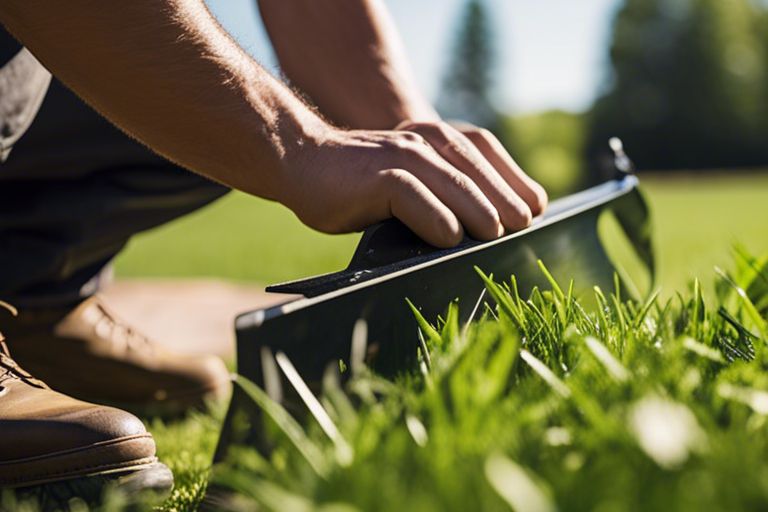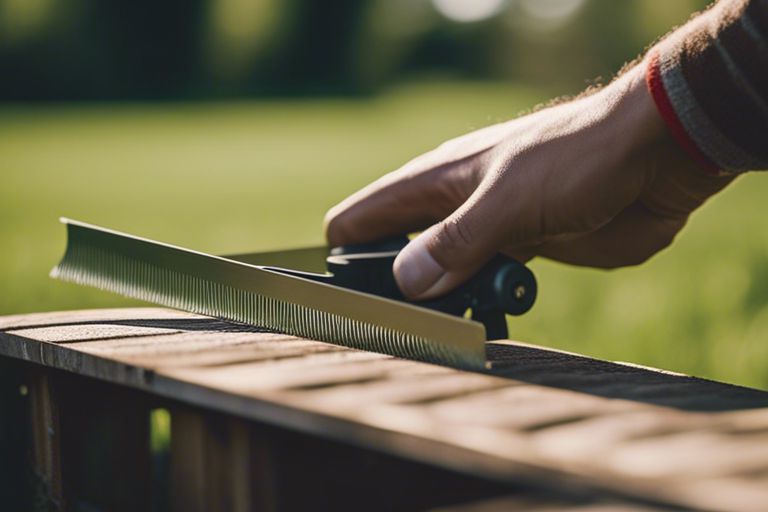Sharpening your lawn mower blade without removing it can help maintain your lawn mower’s efficiency and save you time. In this guide, we will walk you through the step-by-step process of sharpening your lawn mower blade while it is still attached to the mower. Follow these simple instructions to keep your lawn looking its best without the hassle of removing and reattaching the blade.
Key Takeaways:
- Regular sharpening: Sharpening your lawn mower blade without removing it is possible and important to maintain the efficiency of your lawn mower.
- Use a file or grinder: You can use a file or a grinder to sharpen the blade while it is still attached to the lawn mower. Just be cautious and follow safety precautions.
- Balance the blade: After sharpening, make sure to balance the blade to prevent vibrations and ensure even cutting across the lawn.

Preparatory Steps
Safety Considerations
Even before attempting to sharpen a lawn mower blade without removing it, it is crucial to prioritize safety. This task involves working with sharp objects and power tools, so precautions must be taken to avoid any potential accidents.
Tools Required for Sharpening
Some necessary tools needed for sharpening a lawn mower blade include a workbench, clamp, file, safety gloves, and a blade balancer. These tools will help you efficiently sharpen the blade without the need for removing it from the mower.
The workbench provides a stable surface to work on, while the clamp secures the blade in place during sharpening. Safety gloves protect your hands from any sharp edges, and a blade balancer ensures that the blade is evenly sharpened for optimal cutting performance.
To start sharpening the lawn mower blade without removing it, gather all the necessary tools and ensure they are in good working condition. Following the proper safety precautions and using the correct tools is necessary to successfully sharpen the blade and maintain a healthy lawn.
Sharpening the Blade In-Situ
Cleaning the Blade
In situ blade sharpening begins with cleaning the blade thoroughly. Use a wire brush or scraper to remove any built-up grass, dirt, and debris from the blade surface. This step is important to ensure a clean and smooth sharpening process.
The Sharpening Process
Now, let’s explore the sharpening process itself. Secure the lawnmower and make sure the blade is properly fixed in place. Use a file or grinder to sharpen the cutting edge of the blade. Maintain the original angle of the blade edge and file in one direction only, following the blade’s existing angle.
For best results, you can use a blade sharpening kit specially designed for lawnmower blades. These kits come with the necessary tools and guides to help you achieve a precise and sharp edge on your blade.
Another important aspect to consider during the sharpening process is to check for blade balance. An unbalanced blade can cause excessive vibration and damage to your lawnmower. If you notice any imbalance after sharpening, use a blade balancer to adjust the blade accordingly.

Factors Affecting Blade Dullness
Once again, it is important to understand the factors that contribute to the dulling of your lawn mower blade. Here are some key factors to consider:
- Types of Grass
- Lawn Debris and Obstacles
- Frequency of Mowing
- Blade Material
- Mowing Techniques
Perceiving these factors can help you determine the best approach to sharpening your lawn mower blade without the need to remove it.
Types of Grass
Little variations in grass types can impact how quickly your blade dulls. Some grasses are tougher and more fibrous, leading to quicker blade wear. Below are common grass types and their impact on blade dullness:
| Grass Type | Impact |
| Zoysia | Tough and dense, dulls blade faster |
| Bermuda | Hardy and abrasive, dulls blade moderately |
| Fescue | Soft and fine, dulls blade slower |
| St. Augustine | Thick and resilient, dulls blade moderately |
| Kentucky Bluegrass | Dense and vigorous, dulls blade faster |
This knowledge can help you tailor your maintenance routine accordingly to keep your blade sharp.
Lawn Debris and Obstacles
An accumulation of lawn debris such as sticks, rocks, or even toys can cause your blade to dull more quickly. It is crucial to regularly inspect your lawn before mowing to remove any obstacles that could damage the blade.
The presence of obstacles and debris not only dulls the blade but also poses a safety risk and can damage your mower. Maintaining a clear lawn will not only extend the life of your blade but also ensure a smoother and safer mowing experience.
Frequency of Mowing
Now, the frequency of mowing plays a significant role in blade dullness. Mowing too often or letting the grass grow too tall between cuts can accelerate blade wear. It is imperative to find a balance and adhere to a regular mowing schedule to prevent excessive wear on the blade.
Affecting your mowing habits based on the growth rate of your grass and environmental conditions can help maintain a sharp blade and a healthy lawn.

Maintenance Tips for Prolonged Sharpness
To ensure your lawn mower blade stays sharp without having to remove it frequently, follow these maintenance tips:
- Regularly clean the underside of your mower to prevent buildup that can dull the blade.
- Inspect the blade for any damage or signs of wear, and repair or replace as necessary.
- Keep the blade balanced to prevent uneven wear and maintain cutting effectiveness.
Recognizing the importance of these maintenance tasks will help you prolong the sharpness of your lawn mower blade and ensure a well-manicured lawn.
Proper Mowing Techniques
Little adjustments in your mowing habits can go a long way in maintaining a sharp blade. Avoid cutting grass too short, as this can put unnecessary strain on the blade and lead to faster dulling. Instead, follow the one-third rule – never remove more than one-third of the grass blade’s height in one mowing session. This will promote healthier grass growth and reduce the stress on your blade.
Regular Blade Inspection and Care
Proper care and regular inspection of your lawn mower blade are important for its longevity and cutting performance. Techniques such as sharpening the blade with a file or grinder when needed, and ensuring it is securely tightened to prevent wobbling during operation, are key steps in maintaining sharpness. A sharp blade not only cuts grass more effectively but also reduces strain on the mower’s engine, resulting in better overall performance.
Conclusion
On the whole, learning how to sharpen a lawn mower blade without removing it can be a convenient and time-saving task for keeping your lawn looking neat and well-trimmed. By following the proper steps and using the right tools, you can ensure that your lawn mower performs at its best, resulting in a cleaner cut and healthier grass. Regular maintenance and attention to the blade’s sharpness will not only make your mowing job easier but also prolong the lifespan of your lawn mower.
FAQ
Q: Why is it important to sharpen a lawn mower blade?
A: Sharpening a lawn mower blade is imperative to maintain a healthy lawn. Dull blades tear the grass rather than cutting it, which can lead to a ragged appearance and leave your lawn susceptible to diseases.
Q: How can I tell if my lawn mower blade needs sharpening?
A: You can tell your lawn mower blade needs sharpening if the grass tips look torn instead of cleanly cut. You may also notice an unevenness in your lawn after mowing, or hear a loud, vibrating noise coming from your mower.
Q: Can I sharpen a lawn mower blade without removing it?
A: Yes, you can sharpen a lawn mower blade without removing it. However, it is important to take safety precautions by disconnecting the spark plug and securing the blade properly before sharpening.
Q: What tools do I need to sharpen a lawn mower blade without removing it?
A: To sharpen a lawn mower blade without removing it, you will need a socket wrench, blade balancer or sharpening tool, safety gloves, and eye protection.
Q: How often should I sharpen my lawn mower blade?
A: It is recommended to sharpen your lawn mower blade at least once a year or more frequently if you have a large lawn or mow over rough terrain. Regular maintenance will ensure a clean cut and a healthier lawn.
